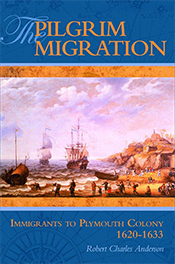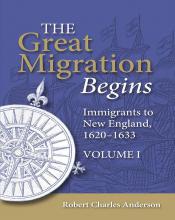STEPHEN HOPKINS
ORIGIN: London
MIGRATION: 1620 on Mayflower
FIRST RESIDENCE: Plymouth
OCCUPATION: Tanner and merchant.
FREEMAN: In the "1633" list of Plymouth freemen Stephen Hopkins is near the head of the list, included among the assistants [PCR 1 :3]. In list of Plymouth Colony freemen, 7 March 1636/7 (as "Steephen Hopkins, gen.") [PCR 1:52]. In the Plymouth section of the 1639 Plymouth Colony list of freemen (as "Mr. Steephen Hopkins," annotated "dead") [PCR 8:173].
EDUCATION: He signed his will. The inventory included "diverse books" valued at 12s. [PCPR 1:63]
OFFICES: Assistant, 1633-36 [PCR 1:5, 21, 32, 36]. Volunteered for service in the Pequot War, 1637 [PCR 1 :61].
ESTATE: In the 1623 Plymouth division of land "Steven Hobkins" received six acres as a passenger on the Mayflower [PCR 12:4]. In the 1627 Plymouth division of cattle Stephen Hopkins, his wife Elizabeth Hopkins, Gyles Hopkins, Caleb Hopkins and Deborah Hopkins are the first five persons in the seventh company, and Damaris Hopkins is the thirteenth person in the eighth company [PCR 12:11, 12].
In the Plymouth tax list of 25 March 1634 Stephen Hopkins was assessed £1 7s., and in the list of 27 March 1634 £1 1 Os. [PCR 1 :9, 27]. "Steven Hopkins" was one of the Purchasers [PCR 2:177].
On 1 July 1633 "Mr. Hopkins" was ordered to mow where he had mowed the year before [PCR 1:15], followed by similar orders on 14 March 1635/6 and 20 March 1636/7 [PCR 1:41, 57].
On 5 February 1637/8 "Mr. Stephen Hopkins requesteth a grant of lands towards the Six Mile Brook" [PCR 1:76].
On 7 August 1638 "[l]iberty is granted to Mr. Steephen Hopkins to erect a house at Mattacheese, and cut hay there this year to winter his cattle, provided that it be not to withdraw him from the town of Plymouth" [PCR 1 :93].
On 17 July 1637 "Steephen Hopkins of Plymouth, gent.," sold to George Boare of Scituate, yeoman, "all that his messuage, houses, tenements, outhouses lying and being at the Broken Wharfe towards the Eele River together with the six shares of lands thereunto belonging containing six acres" [PCR 12:21]. On 30 November 1638 "Mr. Steephen Hopkins" sold to Josias Cooke "all those his six acres of land lying on the south side of the Town Brook of Plymouth" [PCR 12:39]. On 8 June 1642 William Chase mortgaged to "Mr. Stephen Hopkins ... all that his house and lands in Yarmouth containing eight acres of upland and six acres more lying at the Stony Cove" [PCR 12:83].
On 1 June 1640 "Mr. Hopkins" was granted twelve acres of meadow [PCR 1:154, 166].
In his will, dated 6 June 1644 and proved 20 August 1644, Stephen Hopkins "of Plymouth ... weake yet in good and perfect memory" directed that he be buried "as near as conveniently may be to my wife, deceased," and bequeathed to "son Giles Hopkins" the great bull now in the hands of Mrs. Warren; to "Steven Hopkins my son Giles his son" 20s. in Mrs. Warren's hands; to "daughter Constanc[e] Snow, wife of Nicholas ... my mare"; to "daughter Deborah Hopkins" cows; to "daughter Damaris Hopkins" cows; to "daughter Ruth" cows; to "daughter Elizabeth" cows; to "four daughters Deborah, Damaris, Ruth and Elizabeth Hopkins" all the moveable goods; if any of the daughters die, their share to be divided equally among the survivors; to "son Caleb heir apparent" house and lands at Plymouth, one pair of oxen and hire of them and all the debts "now owing unto me"; daughters to have free recourse to use of the house in Plymouth while single; "son Caleb" executor; Caleb and Captain Standish joint supervisors [PCPR 1:1:61].
The inventory of the estate of Stephen Hopkins was taken 17 July 1644 and was untotalled, with no real estate included [PCPR 1:62-63].
On 28 October 1644 "Caleb Hopkins son and heir unto Mr. Steephen Hopkins of Plymouth deceased" deeded to "Gyles Hopkins of Yarmouth, planter, one hundred acres of those lands taken up for the Purchasers of Satuckquett which said lands do accrue unto the said Steephen as a Purchaser" [PCR 12:104].
BIRTH: By about 1579 based on estimated date of first marriage.
DEATH: Plymouth between 6 June 1644 (date of will) and 17 July 1644 (probate of will).
MARRIAGE: (1) By 1604 Mary _____. She was buried at Hursley, Hampshire, 9 May 1613 [TAG 73:169].
(2) St. Mary Matfellon, Whitechapel, London, 19 February 1617/8 Elizabeth Fisher. She died at Plymouth sometime in the early 1640s before her husband, who desired to be buried near her; Bradford indicated that both she and her husband had lived in Plymouth above twenty years.
CHILDREN:
With first wife
- ELIZABETH, bp. Hursley, Hampshire, 13 May 1604 [TAG 73:170]; living on 12 May 1613 [TAG 73:165]; no further record.
- CONSTANCE, bp. Hursley, Hampshire, 11 May 1606 [TAG 73:170]; m. Plymouth by 1627 NICHOLAS SNOW [PM 428] (in the 1627 Plymouth division of cattle "Nickolas Snow" and "Constance Snow" were the sixth and seventh persons in the seventh company, which was headed by Stephen Hopkins [PCR 12: 11 ]).
- GILES, bp. Hursley, Hampshire, 30 January 1607 /8 [TAG 73: 170]; m. Plymouth 9 October 1639 Catherine Whelden [PCR 1:134; TAG 48:5].
With second wife
- DAMARIS, b. say 1618; probably died at Plymouth before the birth of her sister of the same name.
- OCEANUS, b. at sea on the Mayflower voyage between 16 September and 11 November 1620; died by 1627.
- CALEB, b. Plymouth say 1624; "became a seaman & died at Barbadoes" between 1644 and 1651 [Bradford 445].
- DEBORAH, b. Plymouth say 1626; m. Plymouth 23 April 1646 as his first wife Andrew Ring [PCR 2:98; TAG 42:202-05], daughter of widow MARY RING.
- DAMARIS, b. Plymouth say 1628; m. Plymouth shortly after 10 June 1646 Jacob Cooke [MD 2:27-8], son of FRANCIS COOKE [PM 144]. (Since this Damaris was still bearing children in the early 1670s, she cannot be the same as the Damaris who came on the Mayflower.)
- RUTH, b. Plymouth say 1630; d. after 30 November 1644 and before spring 1651 [Bradford 445]; unm.
- ELIZABETH, b. Plymouth say 1632; believed to have died by 6 October 1659 when her property was appraised "in case Elizabeth Hopkins do come no more" [MD 4:114- 19]; unm.
COMMENTS: Caleb Johnson's discovery [TAG 73:161-71] of the family of Stephen Hopkins in Hursley, Hampshire, at last definitively eliminates the suggestion that Stephen Hopkins was son of Stephen Hopkins, a clothier, of Wortley, Wooten Underedge, Gloucestershire [MF 6:3, citing "[t]he Wortley historian"].
Johnson's discovery also strengthens the argument that this was the same Stephen Hopkins who was the minister's clerk on the vessel Sea Venture which met with a hurricane in 1609 while on a voyage to Virginia [TAG 73: 165-66]. One of one hundred and fifty survivors marooned on a Bermuda, he fomented a mutiny and was sentenced to death, but "so penitent he was and made so much moan, alleging the ruin of his wife and children in this his trespass," that his friends procured a pardon from the Governor [MF 6:3, citing William Strachey's account]. (This episode is one of the underlying sources for Shakespeare's The Tempest.)
A brief docket item in official English records raises tantalizing possibilities. On 20 September 1614, a letter was sent "to Sir Thomas Dale Marshall of the Colony in Virginia, to send home by the next return of ships from thence Eliezer Hopkins" [Calendar of State Papers, Domestic Series, of the Reign of James L 1611-1618 (London 1858), p. 253; Calendar of State Papers, Colonial Series, 1574-1660 (London 1860), p. 17]. Examination of the original of this record by Michael J. Wood verifies that this is the correct reading, and the docket item does not refer to Stephen Hopkins. (The letter itself apparently does not survive.)
In his listing of the Mayflower passengers Bradford included "Mr. Stephen Hopkins and Elizabeth his wife, and two children called Giles and Constanta, a daughter, both by a former wife. And two more by this wife called Damaris and Oceanus; the last was born at sea. And two servants called Edward Doty and Edward Lester" [Bradford 442). Stephen Hopkins signed the Mayflower Compact. In his accounting of this family in 1651 Bradford reported that "Mr. Hopkins and his wife are now both dead, but they lived above twenty years in this place and had one son and four daughters born here. Their son became a seaman and died at Barbadoes, one daughter died here, and two are married; one of them hath two children, and one is yet to marry. So their increase which still survive are five. But his son Giles is married and hath four children. His daughter Constanta is also married and hath twelve children, all of them living, and one of them married" [Bradford 445).
In June 1621 Steven Hopkins and Edward Winslow were chosen by the governor to approach Massasoit, and Hopkins repeated this duty as emissary frequently thereafter [Young's Pilgrim Fathers 202, 204).
Despite his social standing and his early public service, Stephen Hopkins managed to run afoul of the authorities several times· in the late 1630s. In June of 1636 while an Assistant, he was fined for battery of John Tisdale, whom he "dangerously wounded" [PCR 1:41-42). On 2 October 1637 he was fined for allowing drinking on the Lord's day and the playing of "shovell board" [PCR 1:68) and on 2 January 1637/8 he was "presented for suffering excessive drinking in his house" [PCR 1 :75). On 5 June 1638 he was "presented for selling beer for 2d. the quart, not worth Id. a quart" [PCR 1:87]; for this and other similar infractions he was on 4 September 1638 fined £5 [PCR 1:97). He dealt harshly with his pregnant servant Dorothy Temple and only the intercession of John Holmes freed him from being held in contempt of court [PCR 1:111-13). In December 1639 he was presented for selling a looking glass for 16d. when a similar glass could be bought in the Bay for 9d. [PCR I: 137).
BIBLIOGRAPHIC NOTE: In 1992 John D. Austin published an excellent and extensive account of Stephen Hopkins and his descendants as the sixth volume in the Five Generations Project of the General Society of Mayflower Descendants [cited herein as MF6). In 1998 Caleb Johnson published his discovery of the baptismal place of the children of Stephen Hopkins and his first wife [TAG 73:161-71]

The Pilgrim Migration: Immigrants to Plymouth Colony 1620-1633
Buy the print edition of The Pilgrim Migration: Immigrants to Plymouth Colony 1620-1633.

The Great Migration Begins: Immigrants to New England 1620-1633
Buy the print edition of The Great Migration Begins: Immigrants to N.E. 1620-1633 Vols I-III.
Become an American Ancestors.org member to access this biography and over 40,000 more records in the searchable online database of The Great Migration Begins: Immigrants to N.E. 1620-1633 Vols I-III.
This authoritative work by Robert Charles Anderson identifies and describes all Europeans who settled in New England prior to the end of 1633. Each individual or family entry includes (when known) the port or country of origin; when and on what ship they arrived in New England; the earliest known record of the individual or family; their first and subsequent residences; return trips to their country of origin; marriages, births, and deaths; and other important family relationships. This work is available in print and database form on AmericanAncestors.org.




